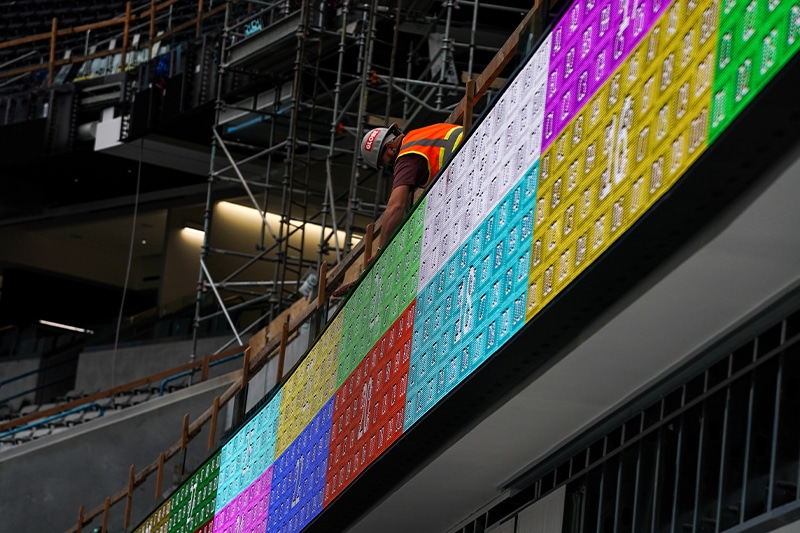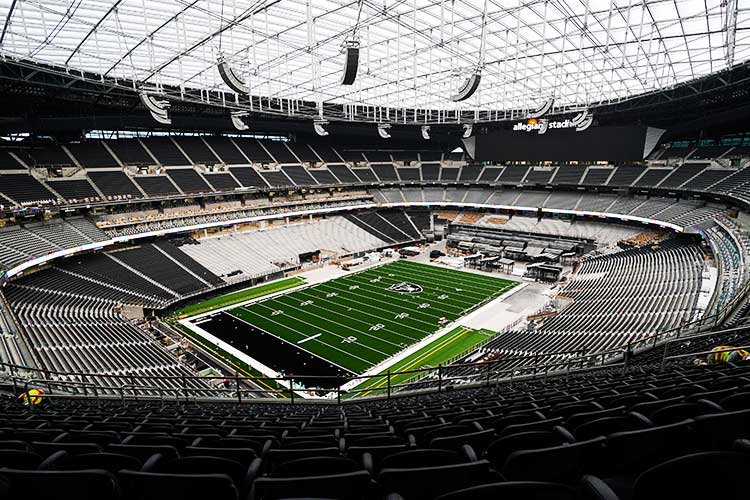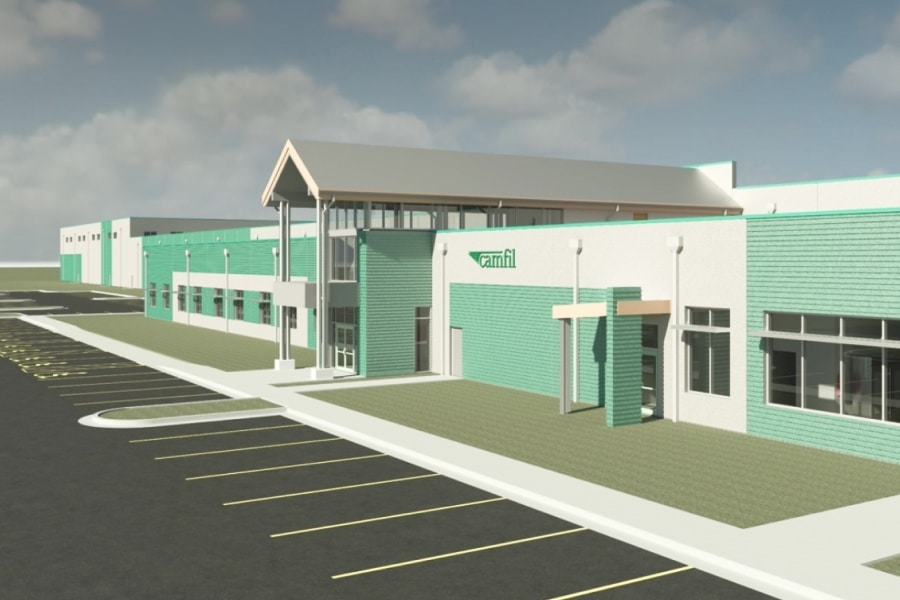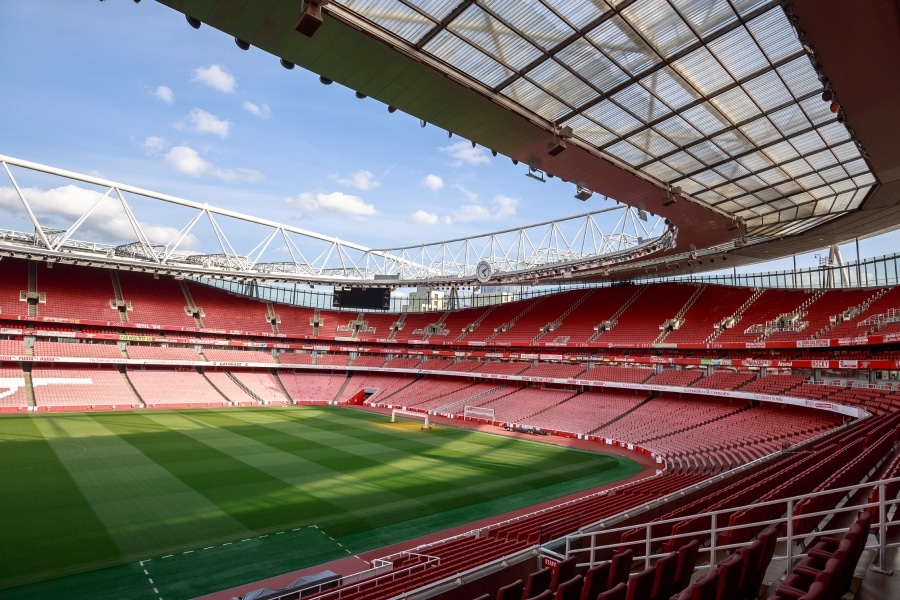During the second week of the National Football League’s 2020 season, which starts September 10, the Las Vegas Raiders will welcome the New Orleans Saints to the team’s brand-new home field, Allegiant Stadium.
Designed by MANICA Architecture, the 65,000-seat, air-conditioned arena will host its first home game in the stadium’s history to what should have been a full house. The team reported earlier in the year that both pre-sale and season tickets were completely sold out before construction of the stadium had even been completed. However, the seats in the large, shiny black stadium that sits right off the city’s famous Strip will remain empty during at least the beginning of the season as both the state of Nevada and the country continue to grapple with the ongoing spread of COVID-19.
With Allegiant closed to fans for the time-being, photos of the stadium, both during and after construction, show what fans can expect to experience—first as they watch on TV and then, hopefully, in person later in the season.
For fans of both the University of Las Vegas Rebels—whose entire season has been postponed due to the pandemic—and the spectator-less inaugural Las Vegas Raiders season, these images provide a glimpse of the spectacular Allegiant Stadium design that resulted from the years-long construction project.
The Raiders, who began practicing at their new venue just weeks ago, have already given the impressive structure glowing reviews. Scenes of the team taking the field for the first time revealed a re-energized roster, excited to loosen up under the stadium’s impressive seven-acre translucent polymer dome.

Made from ethylene tetrafluoroethylene (ETFE)—a light, clear “membrane”—Allegiant Stadium’s roof allows for natural light and is suspended by nearly 10 miles of wire rope. The desert sun illuminates the field by day, as the climate-controlled environment within keeps both players and fans protected from the punishing Las Vegas heat—which, during the fall football season, is thankfully moderate compared to the city’s summer months.
Allegiant Stadium might be shared with the NCAA’s UNLV Rebels, but the playing surfaces for the teams will remain separate, thanks to a 19-million-pound, four-foot deep, retractable sliding “field tray.”

The Raiders will play their games on a natural grass surface that transitions to artificial turf for UNLV Rebels games. The turf field will take about 90 minutes to move out of the stadium in between games, using 72 electric motors along a train-like track, which reveals the artificial turf beneath.
Once fans are welcomed to attend games at Allegiant, they will revel in the fruits of the cost and labor (estimated at $1.9 billon) as they enjoy clear sight-lines, enhanced by nearly 2,000 LED screens of varying size and shape placed throughout the stadium, including the largest interior screen—measuring 254-by-49 feet at the stadium’s south end. With fans unable to attend games this season, expect traffic to slow along Interstate 15, where a 27,600-square-foot mesh videoboard will play game highlights on a loop outside the stadium.
Lighting up the Las Vegas night is practically a requirement for any structure vying for attention in a metropolis already throbbing from the glow of an unmatched abundance of architectural styles. Yet, even Allegiant’s outdoor lightboard is not the largest in Vegas, though the gameplay displayed on it might bring it more attention than most, especially with inside access to the stadium still on hold.
Featuring 127 premium suites, 8,000 club seats and nine premium lounges, Allegiant Stadium has the capacity to expand to accommodate an additional 10,000 spectators (75,000 total) for entertainment events and championship games.

Still, of all the state-of-the-art features of the new Allegiant Stadium design—from the retractable playing surface to the translucent roof and its climate-controlled interior—none can match the permanent tribute to the Raiders late, iconic owner, Al Davis.
An 85-foot tall memorial torch, lit for every game played, replicates a tradition that was formerly practiced when the team resided in Oakland, California. So, while the torch isn’t necessarily a new feature unfamiliar to Raiders fans, according to the Las Vegas Review-Journal the structure is comprised of carbon fiber and aluminum and is the largest construction in the world made from a 3D printer.
With all that the new Allegiant Stadium design has to offer, its inaugural season will unfortunately lack its most important feature: the deafening roar of a Raiders crowd.
To paraphrase Frank Sinatra, the beloved icon, whose eternal presence manages to still linger along the glittering Strip, this can only mean that the best is yet to come.
Take a look inside the top stadium projects opening in 2020.











